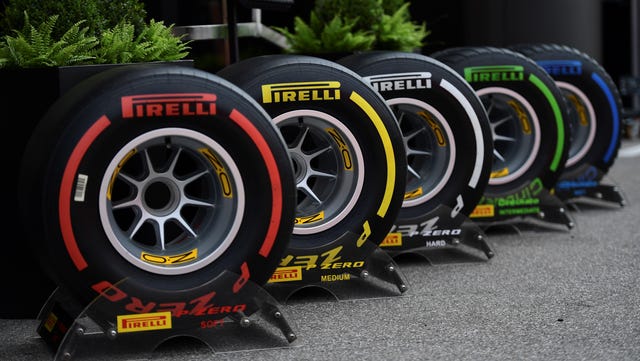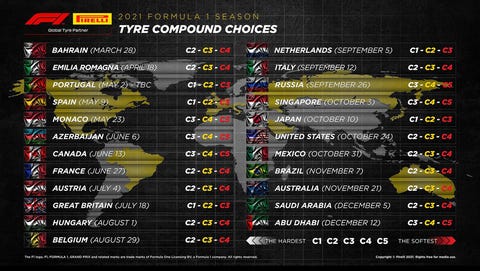When it comes to fresh tires, Formula 1 teams have plenty of options.
For 2021, F1 cars will use seven tire compounds, including five slick compounds for dry tracks and two rain compounds for wet tracks. Those tire compounds range in varying levels of rubber hardness.
Manufacturer Pirelli brings to each race three different compounds from of its supply of five dry-track slicks. Pirelli labels the compounds on its schedule C1, C2, C3, C4 and C5, with C1 being the hardest and C5 the softest.
Teams and fans can identify the sets on race weekend by colors. Two of these colors (green, and blue) are only used on wet track conditions. The remaining three tire colors (white, yellow, green) are used for dry selections. When watching a race, note that the whites are hardest dry compound available for teams to use, while yellow signifies the mediums and red the softest available tires.
On a rainy track, the intermediate wet (green) compound discards roughly eight gallons of water per second for each tire, whereas the full wet compound (blue) can remove up to 22 gallons of water per second from its treads.
Fun facts
• Slick tires were introduced into F1 at the 1971 Spanish Grand Prix by tire manufacturer Goodyear. Tire competition was sparked in 1997 when Bridgestone joined Goodyear as a tire supplier in the series.
• Goodyear left the sport after the 1998 season. leaving Bridgestone to be the sole tire provide until Michelin made F1 a two-tire series in 2001.
• Michelin left F1 in 2007, leaving Bridgestone as the sole supplier through 2010.
• Pirelli, which supplied tires off and on to the series from 1950 until 1991, returned in 2011 and has been the sole tire supplier to the series ever since.
• Tire competition has led to as many as six different tire manufactures at the same time in F1. The last time six tire companies battled in F1 was when Donlop, Englebert, Continental, Pirelli, Firestone and Avon supplied cars for the 1958 F1 championship season.
Source: Read Full Article



